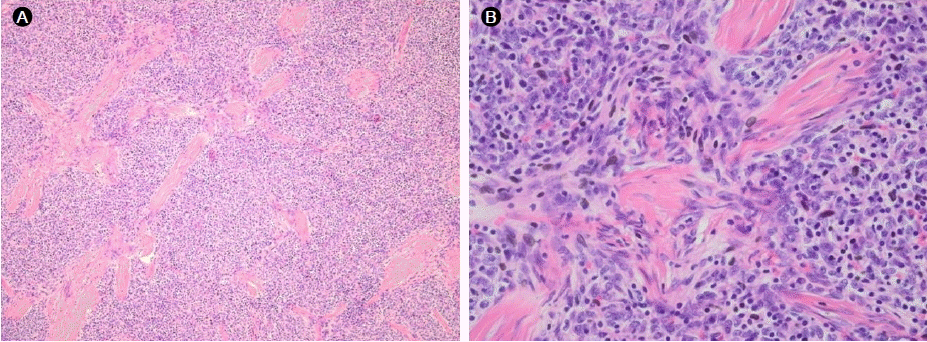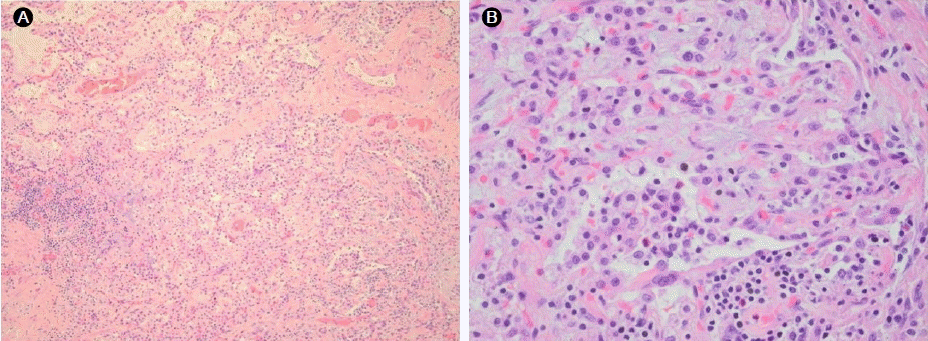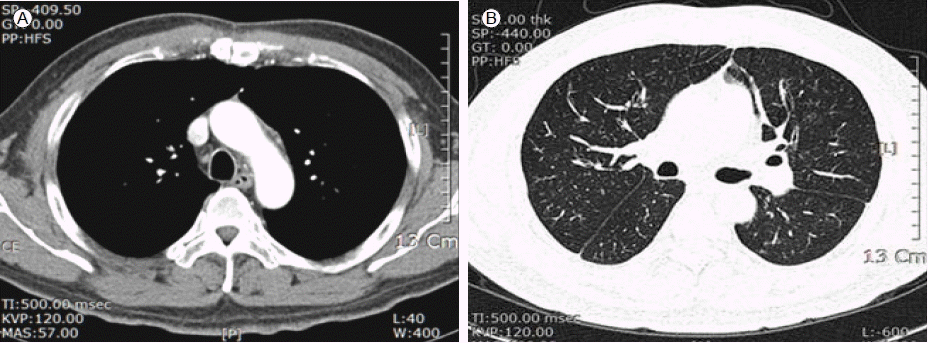INTRODUCTION
Thymoma is the most common neoplasm of the thymus gland. Recent reports have shown incidence estimates of 0.15 per 100,000 person-years in the United States [1]. Thymoma accounts for 20% of mediastinal tumors and is the most common tumor of the anterior mediastinum, accounting for approximately 50% of the anterior mediastinal tumors in adults [2]. Organizing pneumonia (OP) is a disease resulting from pulmonary reaction to noxious factors and is defined histologically. Regions of OP often accompany lung cancer and are not the predominant clinical, radiological, or pathological features [3]. Thymoma with OP located in both lungs is very rare. Moreover, disappearance of OP after resection of thymoma has not been reported previously. Having searched the literature, no similar co-existence of thymoma and OP was noted. We report a 55-year-old male with spontaneous resolution of OP following surgery for thymoma.
CASE REPORT
A 55-year-old current smoker (15 pack-years) was admitted to the Kangnam Hospital of Hallym University on July 16, 2009 with diagnosis of an anterior mediatinal mass. His medical history revealed that he was a hepatitis B virus carrier. Three weeks before admission, the patient complained of dry cough and shortness of breath. On physical examination, the patient was in generally good health, except for dyspnea on exertion. Auscultation revealed crackling sounds in the bases of both lungs. On admission, a chest X-ray revealed an anterior mediastinal mass and reticulonodular densities were noted in both lungs. Forced vital capacity (FVC) and forced expiratory volume in one second (FEV1) were 1.52 L (38% of predicted value) and 0.90 L (30% of predicted value), respectively. FEV1/FVC was 59%. A pulmonary function test revealed a mixed obstructive and restrictive pattern. A chest computed tomography (CT) scan demonstrated a 6.5 × 5.7 cm, well-demarcated and enhanced anterior mediastinum mass, and diffuse centrilobular nodules with tree-in-bud appearance were noted in both lungs (Fig. 1). Repeated sputum cultures for mycobacteria and other pathogens were negative. Acetyl-choline receptor (AChR)-binding antibodies were normal (0.2 nmol/L; normal, < 0.30 nmol/L), and there was no association with myasthenia gravis.
The patient underwent radical surgical procedures (extended total thymectomy and left upper lung wedge resection). Histological examination showed WHO Thymoma classification type AB (mixed) thymoma (Fig. 2). A lung-wedge resection specimen (left upper lobe) contained fragments of alveolar parenchyma with inflammation and intra-alveolar purulence consistent with OP (Fig. 3). Neoplastic cells were not found. The postoperative period was uneventful, and follow-up films showed that the previous reticulonodular infiltrations were markedly absorbed. After 1 month, a follow-up chest CT scan showed remarkable improvement in the previous centrilobular nodules in both lungs (Fig. 4). The patient remains asymptomatic to-date, with no recurrence of thymoma.
DISCUSSION
Thymoma is associated with various autoimmune disorders and secondary malignancy. Such autoimmune disorders may include myasthenia gravis, polymyositis, lupus erythematosus, rheumatoid arthritis, thyroiditis, Sjogren's syndrome, and hypogammaglobulinemia. There have also been occurrences of thymoma in patients with non-Hodgkin’s lymphoma and soft tissue sarcoma [4]. However, thymoma with organizing pneumonia (OP) located in both lungs is very rare.
OP is characterized by the accumulation of organized exudates within the alveoli, protruding into the small bronchioli and alveolar ducts in the form of polyps [1]. Cryptogenic organizing pneumonia (COP) is determined when no definitive cause or characteristic clinical context is found. Many diseases and conditions may trigger secondary OP. In secondary OP, causes such as infection, especially Mycoplasma pneumoniae, Chlamydophila pneumoniae, and viruses, can be identified, or it might be the consequence of exposure to toxic substances, such as drugs or radiotherapy. Secondary OP has been observed in autoimmune and neoplastic disorders [5]. In several studies, it was found that there is no radiological, clinical, or histopathological difference between secondary and primary OP; however, generally, secondary OP has a worse prognosis. Its clinical manifestation comprises fever, dry or productive cough, dyspnea of varying severity, chest pain, sweats, and weakness. The most common radiographic abnormalities in OP are bilateral, patchy airspace opacities. Bilateral, migratory parenchymal infiltrates with air bronchogram is the most common radiological sign of OP, but also centrilobular nodules 3-5 mm in diameter confined to one lung or disseminated, bilateral, reticulonodular forms can be found. Nodular patterns of OP are represented as well-defined acinar or subtle, poorly defined nodular patterns [6]. Diffuse nodular patterns mimic miliary tuberculosis [7]. Several recent reports have noted that OP can develop from neoplastic disorders. OP may accompany lung cancer as a result of the direct influence of the tumor on the surrounding lung parenchyma or as a consequence of bronchial obstruction [8].
The mainstay treatment for thymoma is surgery with the goal of achieving a complete surgical resection as the main determinant of survival. OP associated with thymoma is rare, and there has not been a case report of it. The present case represents a very unusual radiographic manifestation of OP, with thymoma and a diffuse nodular pattern that mimics miliary tuberculosis. The standard treatment for OP is corticosteroids, but in some cases treated this way, spontaneous regression was observed. This has already been described in other, smaller case series or case reports. Some patients that were not treated with corticosteroids nevertheless showed improvement [9]. Another study showed that this phenomenon occurred most often in patients with focal lesions that were surgically removed. It is possible that surgery cures the disease in such cases [10].







 PDF Links
PDF Links PubReader
PubReader ePub Link
ePub Link Full text via DOI
Full text via DOI Download Citation
Download Citation Print
Print






